Using Open Street Map Data in Environmental Exposure Assessment Studies: Eastern Massachusetts, Bern Region, and South Israel as a Case Study
Abstract
1. Introduction
2. Materials and Methods
2.1. Research Area
2.2. Data Collection and Preparation
2.3. Assessing Data Quality
2.4. Exposure Assessment Comparison
2.4.1. Distance to Nearest Major Road
2.4.2. Road Density
3. Results
3.1. Descriptive Statistics
3.2. Data Quality
3.2.1. Completeness
3.2.2. Positional Accuracy
3.3. Exposure Assessment Comparison
3.3.1. Road Density
3.3.2. Distance to Nearest Major Road
4. Discussion
5. Conclusions
Author Contributions
Funding
Acknowledgments
Conflicts of Interest
References
- Stevens, K.B.; Pfeiffer, D.U. Sources of spatial animal and human health data: Casting the net wide to deal more effectively with increasingly complex disease problems. Spat. Spatio-Temporal Epidemiol. 2015, 13, 15–29. [Google Scholar] [CrossRef]
- Maantay, J.A.; McLafferty, S. Environmental Health and Geospatial Analysis: An Overview; Geospatial Analysis of Environmental Health; Springer: Berlin, Germany, 2011; pp. 3–37. [Google Scholar]
- Nichols, G.L.; Andersson, Y.; Lindgren, E.; Devaux, I.; Semenza, J.C. European monitoring systems and data for assessing environmental and climate impacts on human infectious diseases. Int. J. Environ. Res. Public Health 2014, 11, 3894–3936. [Google Scholar] [CrossRef]
- Budhathoki, N.; Nedovic-Budic, Z.; Bruce, B. An interdisciplinary frame for understanding volunteered geographic information. Geomatica 2010, 64, 11–26. [Google Scholar]
- Goodchild, M.F. Citizens as sensors: The world of volunteered geography. GeoJournal 2007, 69, 211–221. [Google Scholar] [CrossRef]
- OSM Fundation. Main Page. 2016. Available online: https://wiki.osmfoundation.org/wiki/Main_Page (accessed on 20 June 2016).
- Haklay, M.; Weber, P. Openstreetmap: User-generated street maps. IEEE Pervas. Comput. 2008, 7, 12–18. [Google Scholar] [CrossRef]
- Díaz, L.; Granell, C.; Gould, M.; Huerta, J. Managing user-generated information in geospatial cyberinfrastructures. Future Gener. Comput. Syst. 2011, 27, 304–314. [Google Scholar] [CrossRef]
- Hagenauer, J.; Helbich, M. Mining urban land-use patterns from volunteered geographic information by means of genetic algorithms and artificial neural networks. Int. J. Geogr. Inf. Sci. 2012, 26, 963–982. [Google Scholar] [CrossRef]
- Qian, X.; Di, L.; Li, D.; Li, P.; Shi, L.; Cai, L. Data Cleaning Approaches in Web2.0 VGI Application. In Proceedings of the 2009 17th International Conference on IEEE, Geoinformatics, Fairfax, VA, USA, 12–14 August 2009; pp. 1–4. [Google Scholar]
- Girres, J.; Touya, G. Quality assessment of the French OpenStreetMap dataset. Trans. GIS 2010, 14, 435–459. [Google Scholar] [CrossRef]
- Flanagin, A.J.; Metzger, M.J. The credibility of volunteered geographic information. GeoJournal 2008, 72, 137–148. [Google Scholar] [CrossRef]
- De Leeuw, J.; Said, M.; Ortegah, L.; Nagda, S.; Georgiadou, Y.; DeBlois, M. An assessment of the accuracy of volunteered road map production in Western Kenya. Remote Sens. 2011, 3, 247–256. [Google Scholar] [CrossRef]
- Nelson, A.; de Sherbinin, A.; Pozzi, F. Towards development of a high quality public domain global roads database. Data Sci. J. 2006, 5, 223–265. [Google Scholar] [CrossRef]
- Senaratne, H.; Mobasheri, A.; Ali, A.L.; Capineri, C.; Haklay, M. A review of volunteered geographic information quality assessment methods. Int. J. Geogr. Inf. Sci. 2017, 31, 139–167. [Google Scholar] [CrossRef]
- See, L.; Comber, A.; Salk, C.; Fritz, S.; van der Velde, M.; Perger, C.; Schill, C.; McCallum, I.; Kraxner, F.; Obersteiner, M. Comparing the quality of crowdsourced data contributed by expert and non-experts. PLoS ONE 2013, 8, e69958. [Google Scholar] [CrossRef]
- Haklay, M. How good is volunteered geographical information? A comparative study of OpenStreetMap and Ordnance Survey datasets. Environ. Plan. B Plan. Des. 2010, 37, 682–703. [Google Scholar] [CrossRef]
- Zielstra, D.; Zipf, A. Quantitative studies on the data quality of OpenStreetMap in Germany. In Proceedings of the GIScience, Zurich, Switzerland, 14–17 September 2010. [Google Scholar]
- Zielstra, D.; Zipf, A. A comparative study of proprietary geodata and volunteered geographic information for Germany. In Proceedings of the 13th AGILE International Conference on Geographic Information Science, Guimarães, Portugal, 11–14 May 2010. [Google Scholar]
- Zielstra, D.; Hochmair, H.H.; Neis, P. Assessing the effect of data imports on the completeness of OpenStreetMap–a United States case study. Trans. GIS 2013, 17, 315–334. [Google Scholar] [CrossRef]
- Koukoletsos, T.; Haklay, M.; Ellul, C. An automated method to assess data completeness and positional accuracy of OpenStreetMap. In Proceedings of the 11th International Conference on Geocomputation, London, UK, 20–22 July 2011. [Google Scholar]
- Hochmair, H.H.; Zielstra, D.; Neis, P. Assessing the Completeness of Bicycle Trail and Designated Lane Features in OpenStreetMap for the United States and Europe. In Proceedings of the Transportation Research Board 92nd Annual Meeting, Washington, DC, USA, 13–17 January 2013. [Google Scholar]
- Z Zielstra, D.; Hochmair, H. Comparative study of pedestrian accessibility to transit stations using free and proprietary network data. Transp. Res. Rec. J. Transp. Res. Board 2011, 145–152. [Google Scholar] [CrossRef]
- Helbich, M.; Amelunxen, C.; Neis, P.; Zipf, A. Comparative Spatial Analysis of Positional Accuracy of OpenStreetMap and Proprietary Geodata; GI_Forum; VDE VERLAG GMBH: Berlin, Germany, 2012. [Google Scholar]
- Koukoletsos, T.; Haklay, M.; Ellul, C. Assessing data completeness of VGI through an automated matching procedure for linear data. Trans. GIS 2012, 16, 477–498. [Google Scholar] [CrossRef]
- Bakri, A.; Fairbairn, D. User Generated Content and Formal Data Sources for Integrating Geospatial Data; Newcastle University: Newcastle, UK, 2012. [Google Scholar]
- Mooney, P.; Corcoran, P. The annotation process in OpenStreetMap. Trans. GIS 2012, 16, 561–579. [Google Scholar] [CrossRef]
- Mocnik, F.; Mobasheri, A.; Griesbaum, L.; Eckle, M.; Jacobs, C.; Klonner, C. A grounding-based ontology of data quality measures. J. Spat. Inf. Sci. 2018, 2018, 1–25. [Google Scholar] [CrossRef]
- Mocnik, F.; Mobasheri, A.; Zipf, A. Open source data mining infrastructure for exploring and analysing OpenStreetMap. Open Geospat. Data Softw. Stand. 2018, 3, 7. [Google Scholar] [CrossRef]
- Kunze, C.; Hecht, R. Semantic enrichment of building data with volunteered geographic information to improve mappings of dwelling units and population. Comput. Environ. Urban Syst. 2015, 53, 4–18. [Google Scholar] [CrossRef]
- Liu, X.; Long, Y. Automated identification and characterization of parcels with OpenStreetMap and points of interest. Environ. Plan. B Plan. Des. 2016, 43, 341–360. [Google Scholar] [CrossRef]
- Bakillah, M.; Mobasheri, A.; Liang, S.H.; Zipf, A. Towards an efficient routing web processing service through capturing real-time road conditions from big data. In Proceedings of the 2013 5th IEEE Computer Science and Electronic Engineering Conference (CEEC), Essex, UK, 17–18 September 2013; pp. 152–155. [Google Scholar]
- Bakillah, M.; Lauer, J.; Liang, S.H.; Zipf, A.; Jokar Arsanjani, J.; Mobasheri, A.; Loos, L. Exploiting big VGI to improve routing and navigation services. In Big Data Techniques and Technologies in Geoinformatics; Taylor & Francis Group: Abingdon-on-Thames, UK, 2014; pp. 177–192. [Google Scholar]
- Hentschel, M.; Wagner, B. Autonomous robot navigation based on openstreetmap geodata. In Proceedings of the 2010 13th International IEEE Conference on Intelligent Transportation Systems (ITSC), Madeira Island, Portugal, 19–22 September 2010; pp. 1645–1650. [Google Scholar]
- Graf, F.; Kriegel, H.; Renz, M.; Schubert, M. MARiO: Multi-attribute routing in open street map. In Advances in Spatial and Temporal Databases; Springer: Berlin, Germany, 2011; pp. 486–490. [Google Scholar]
- Luxen, D.; Vetter, C. Real-time routing with OpenStreetMap data. In Proceedings of the 19th ACM SIGSPATIAL International Conference on Advances in Geographic Information Systems, Chicago, IL, USA, 1–4 November 2011; pp. 513–516. [Google Scholar]
- Yeboah, G.; Alvanides, S. Route Choice Analysis of Urban Cycling Behaviors Using OpenStreetMap: Evidence from a British Urban Environment. In OpenStreetMap in GIScience; Springer: Berlin, Germany, 2015; pp. 189–210. [Google Scholar]
- Imteaj, A.; Chowdhury, M.; Mahamud, M.A. SmartTravel: An approach to redolant Transportation Guiding Application in context of Bangladesh using OpenStreetMap. In Proceedings of the 2015 International Conference on Electrical Engineering and Information Communication Technology (ICEEICT), Savar, Bangladesh, 21–23 May 2015; pp. 1–5. [Google Scholar]
- Jacob, R.; Zheng, J.; Ciepłuch, B.; Mooney, P.; Winstanley, A.C. Campus guidance system for international conferences based on OpenStreetMap. In Web and Wireless Geographical Information Systems; Springer: Berlin, Germany, 2009; pp. 187–198. [Google Scholar]
- Mobasheri, A.; Huang, H.; Degrossi, L.C.; Zipf, A. Enrichment of openstreetmap data completeness with sidewalk geometries using data mining techniques. Sensors 2018, 18, 509. [Google Scholar] [CrossRef] [PubMed]
- Mobasheri, A.; Zipf, A.; Francis, L. OpenStreetMap data quality enrichment through awareness raising and collective action tools—Experiences from a European project. Geo-Spat. Inf. Sci. 2018, 21, 234–246. [Google Scholar] [CrossRef]
- Gil, J. Building a multimodal urban network model using openstreetmap data for the analysis of sustainable accessibility. In OpenStreetMap in GIScience; Springer: Berlin, Germany, 2015; pp. 229–251. [Google Scholar]
- Jia, T. Uncovering structure dynamics of the evolving networks. In Proceedings of the 2015 23rd International Conference on IEEE Geoinformatics, Wuhan, China, 19–21 June 2015; pp. 1–5. [Google Scholar]
- Tarapiah, S.; Atalla, S.; Muala, N.; Tarabeh, S. Offline public transportation management system based on GPS/WiFi and open street maps. In Proceedings of the 2014 Sixth International Conference on, IEEE Computational Intelligence, Communication Systems and Networks (CICSyN), Tetovo, Macedonia, 27–29 May 2014; pp. 182–185. [Google Scholar]
- Moeinaddini, M.; Asadi-Shekari, Z.; Shah, M.Z. The relationship between urban street networks and the number of transport fatalities at the city level. Saf. Sci. 2014, 62, 114–120. [Google Scholar] [CrossRef]
- Mobasheri, A.; Sun, Y.; Loos, L.; Ali, A.L. Are Crowdsourced datasets suitable for specialized routing services? Case study of OpenStreetMap for routing of people with limited mobility. Sustainability 2017, 9, 997. [Google Scholar] [CrossRef]
- Zipf, A.; Mobasheri, A.; Rousell, A.; Hahmann, S. Crowdsourcing for individual needs—The case of routing and navigation for mobility-impaired persons. In European Handbook of Crowdsourced Geographic Information; Department of Geo-Information Processing, University of Twente: Enschede, The Netherlands, 2016; p. 325. [Google Scholar]
- Melbye, D.C.; Møller-Jensen, L.; Andreasen, M.H.; Kiduanga, J.; Busck, A.G. Accessibility, congestion and travel delays in Dar es Salaam–A time–distance perspective. Habitat Int. 2015, 46, 178–186. [Google Scholar] [CrossRef]
- Over, M.; Schilling, A.; Neubauer, S.; Zipf, A. Generating web-based 3D City Models from OpenStreetMap: The current situation in Germany. Comput. Environ. Urban Syst. 2010, 34, 496–507. [Google Scholar] [CrossRef]
- Goetz, M.; Zipf, A. OpenStreetMap in 3D–detailed insights on the current situation in Germany. In Proceedings of the AGILE 2012 International Conference on Geographic Information Science, Avignon, France, 24–27 April 2012; Volume 2427, p. 2427. [Google Scholar]
- Goetz, M. Towards generating highly detailed 3D CityGML models from OpenStreetMap. Int. J. Geogr. Inf. Sci. 2013, 27, 845–865. [Google Scholar] [CrossRef]
- Soden, R.; Palen, L. From crowdsourced mapping to community mapping: The post-earthquake work of openstreetmap Haiti. In Proceedings of the 11th International Conference on the Design of Cooperative Systems (COOP 2014), Nice, France, 27–30 May 2014; Springer: Berlin, Germany, 2014; pp. 311–326. [Google Scholar]
- Zook, M.; Graham, M.; Shelton, T.; Gorman, S. Volunteered geographic information and crowdsourcing disaster relief: A case study of the Haitian earthquake. World Med. Health Policy 2010, 2, 7–33. [Google Scholar] [CrossRef]
- Morley, D.W.; Gulliver, J. Methods to improve traffic flow and noise exposure estimation on minor roads. Environ. Pollut. 2016, 216, 746–754. [Google Scholar] [CrossRef] [PubMed]
- Chen, S.; Bekhor, S.; Broday, D.M. Aggregated GPS tracking of vehicles and its use as a proxy of traffic-related air pollution emissions. Atmos. Environ. 2016, 142, 351–359. [Google Scholar] [CrossRef]
- Brooke, R.J.; Mutters, N.T.; Péter, O.; Kretzschmar, M.E.; Teunis, P.F. Exposure to low doses of Coxiella burnetii caused high illness attack rates: Insights from combining human challenge and outbreak data. Epidemics 2015, 11, 1–6. [Google Scholar] [CrossRef] [PubMed]
- Hasenfratz, D.; Saukh, O.; Walser, C.; Hueglin, C.; Fierz, M.; Arn, T.; Beutel, J.; Thiele, L. Deriving high-resolution urban air pollution maps using mobile sensor nodes. Pervasive Mob. Comput. 2015, 16, 268–285. [Google Scholar] [CrossRef]
- Just, A.C.; Wright, R.O.; Schwartz, J.; Coull, B.A.; Baccarelli, A.A.; Tellez-Rojo, M.M.; Moody, E.; Wang, Y.; Lyapustin, A.; Kloog, I. Using high-resolution satellite aerosol optical depth to estimate daily PM2.5 geographical distribution in Mexico City. Environ. Sci. Technol. 2015, 49, 8576–8584. [Google Scholar] [CrossRef] [PubMed]
- Moulay, D.; Pigné, Y. A metapopulation model for chikungunya including populations mobility on a large-scale network. J. Theor. Biol. 2013, 318, 129–139. [Google Scholar] [CrossRef] [PubMed]
- Hatzopoulou, M.; Weichenthal, S.; Barreau, G.; Goldberg, M.; Farrell, W.; Crouse, D.; Ross, N. A web-based route planning tool to reduce cyclists’ exposures to traffic pollution: A case study in Montreal, Canada. Environ. Res. 2013, 123, 58–61. [Google Scholar] [CrossRef] [PubMed]
- Allen, R.W.; Gombojav, E.; Barkhasragchaa, B.; Byambaa, T.; Lkhasuren, O.; Amram, O.; Takaro, T.K.; Janes, C.R. An assessment of air pollution and its attributable mortality in Ulaanbaatar, Mongolia. Air Qual. Atmos. Health 2013, 6, 137–150. [Google Scholar] [CrossRef] [PubMed]
- Aleksandropoulou, V.; Lazaridis, M. Trends in population exposure to particulate matter in urban areas of Greece during the last decade. Sci. Total Environ. 2017, 581, 399–412. [Google Scholar] [CrossRef] [PubMed]
- Ayres-Sampaio, D.; Teodoro, A.C.; Sillero, N.; Santos, C.; Fonseca, J.; Freitas, A. An investigation of the environmental determinants of asthma hospitalizations: An applied spatial approach. Appl. Geogr. 2014, 47, 10–19. [Google Scholar] [CrossRef]
- United States Census Bureau. Mass Department of Revenue. 2010. Available online: https://www.census.gov/quickfacts/fact/table/bostoncitymassachusetts,MA/PST045217#viewtop (accessed on 6 July 2016).
- Swiss Federal Statistics Office. 2015. Available online: http://www.bfs.admin.ch/bfs/portal/en/index.html (accessed on 6 July 2016).
- Israel Central Bureau of Statistics. Available online: http://www.cbs.gov.il/ (accessed on 20 June 2016).
- GeoFabrik. Available online: http://download.geofabrik.de/index.html (accessed on 8 November 2015).
- Massachusetts Office of Geographic Information (MassGIS). Available online: https://www.mass.gov/service-details/massgis-data-layers (accessed on 6 July 2016).
- GISrael Database of MAPA. Available online: http://www.gisrael.co.il/eng/ (accessed on 10 May 2011).
- Rose, N.; Cowie, C.; Gillett, R.; Marks, G.B. Weighted road density: A simple way of assigning traffic-related air pollution exposure. Atmos. Environ. 2009, 43, 5009–5014. [Google Scholar] [CrossRef]
- Jerrett, M.; Arain, A.; Kanaroglou, P.; Beckerman, B.; Potoglou, D.; Sahsuvaroglu, T.; Morrison, J.; Giovis, C. A review and evaluation of intraurban air pollution exposure models. J. Exposure Sci. Environ. Epidemiol. 2005, 15, 185. [Google Scholar] [CrossRef] [PubMed]
- Eeftens, M.; Beelen, R.; de Hoogh, K.; Bellander, T.; Cesaroni, G.; Cirach, M.; Declercq, C.; Dedele, A.; Dons, E.; de Nazelle, A. Development of land use regression models for PM2.5, PM2.5 absorbance, PM10 and PMcoarse in 20 European study areas; results of the ESCAPE project. Environ. Sci. Technol. 2012, 46, 11195–11205. [Google Scholar] [CrossRef] [PubMed]
- Hunter, G.J.; Goodchild, M.F. Communicating uncertainty in spatial databases. Trans. GIS 1996, 1, 13–24. [Google Scholar] [CrossRef]
- Mapbox. Available online: http://mapbox.github.io (accessed on 18 October 2018).
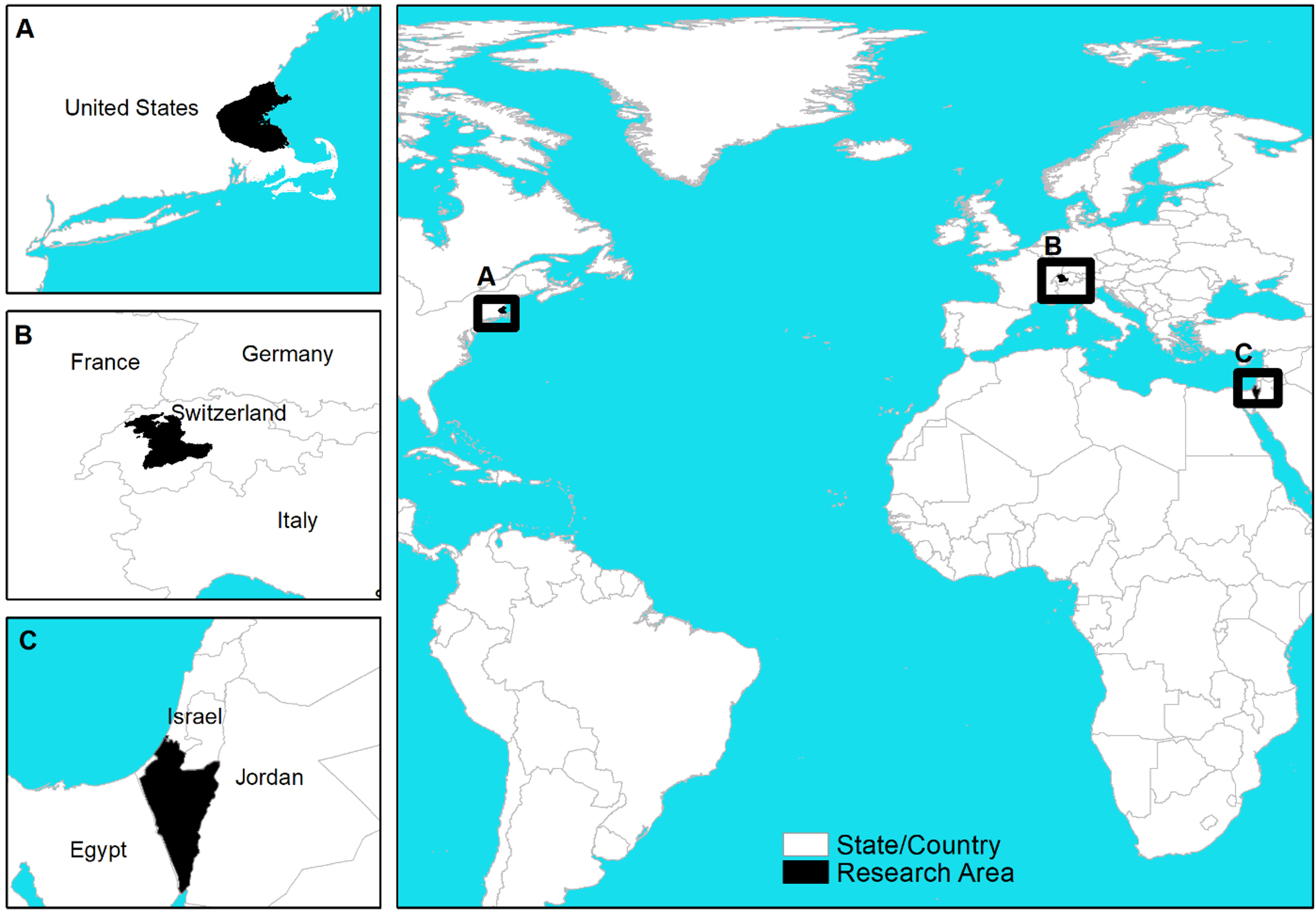

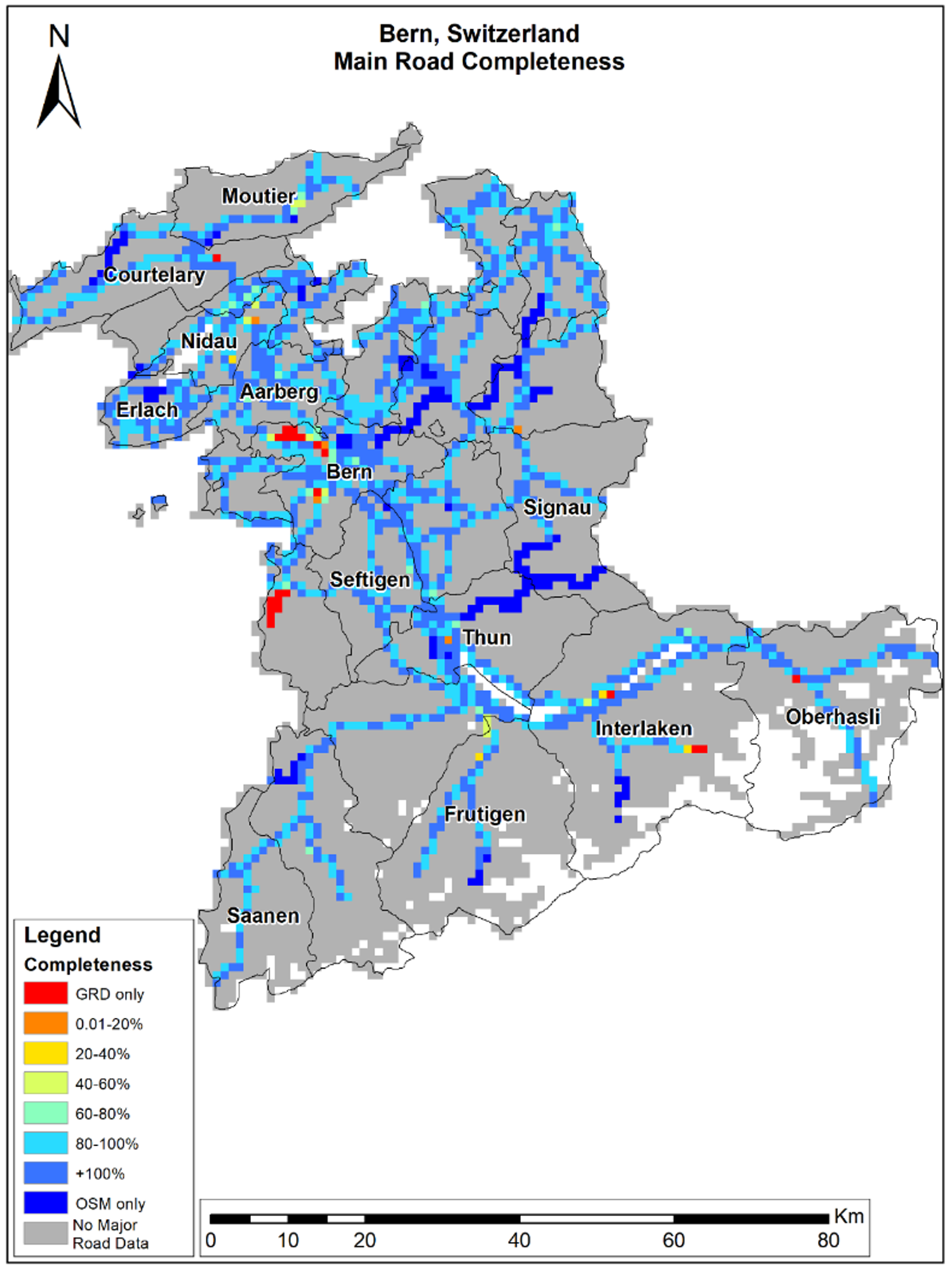
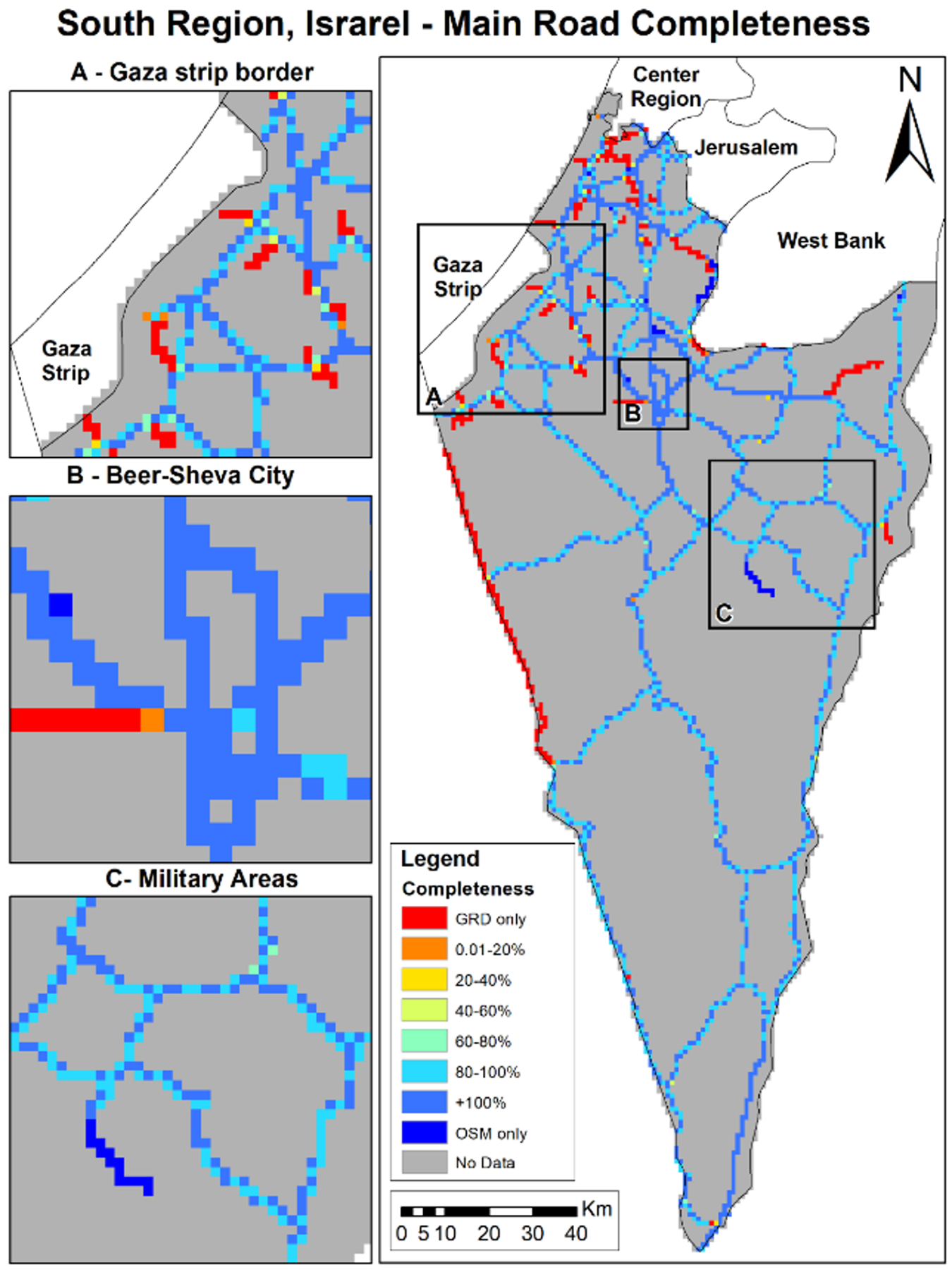
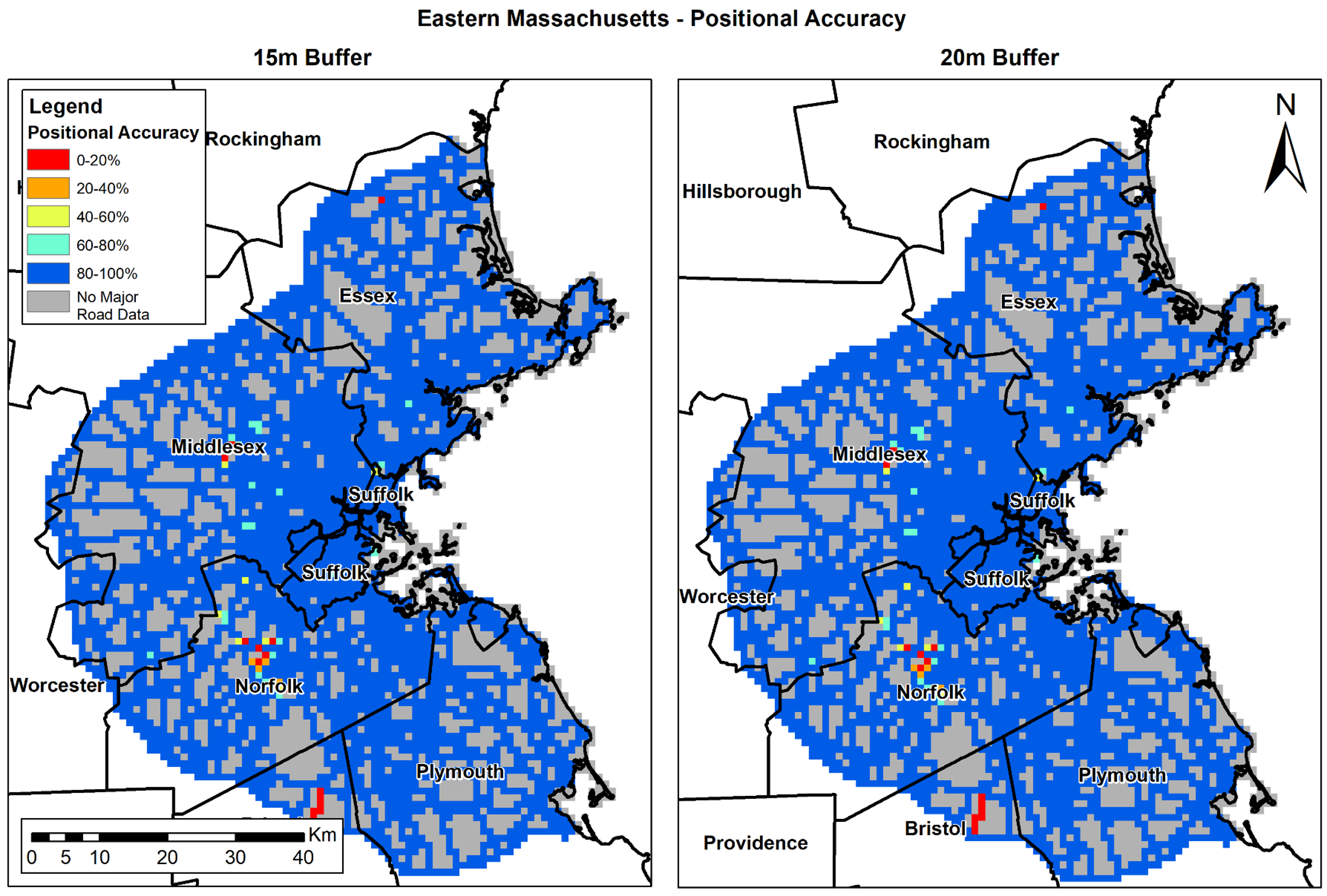

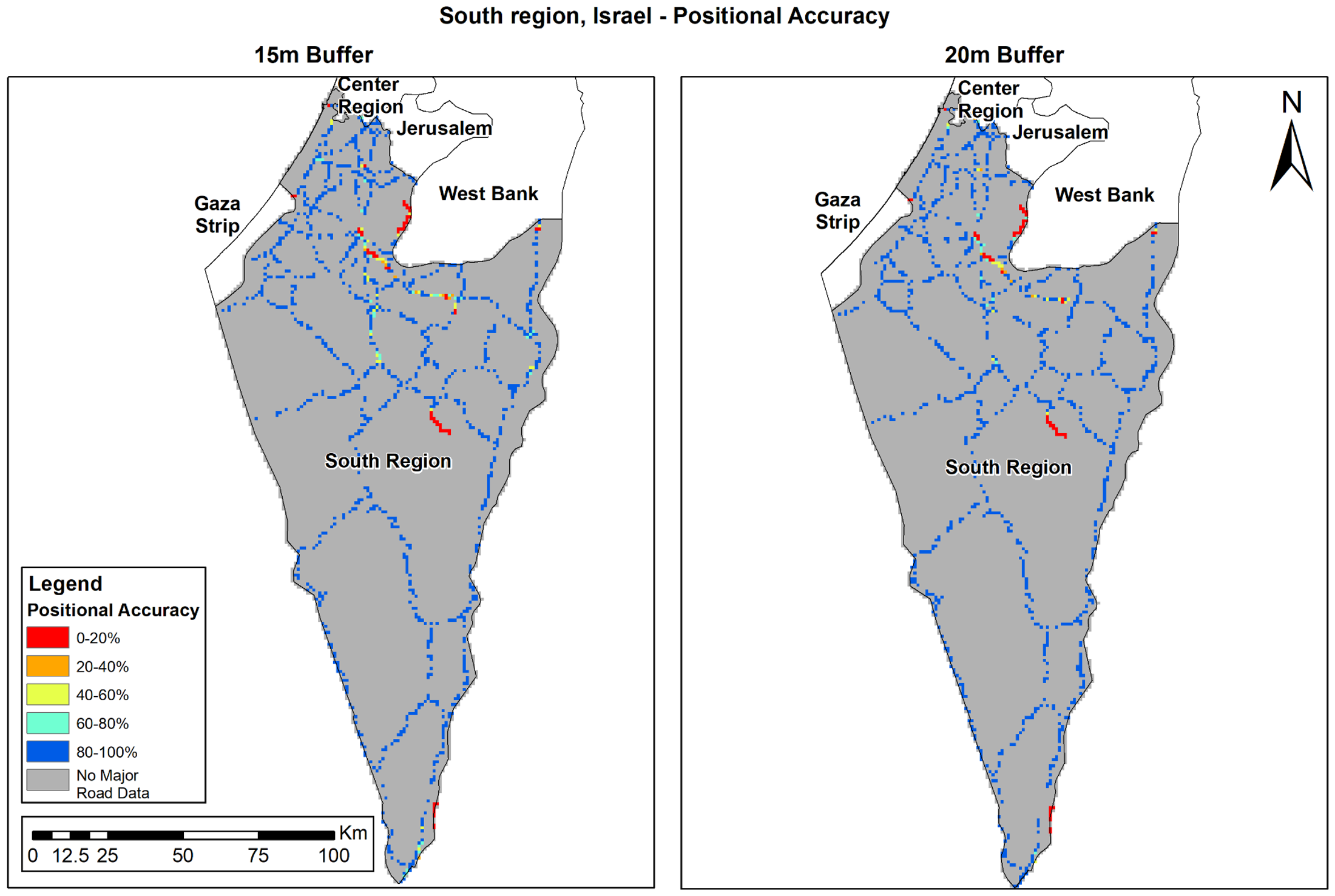
| Reference | Study Area | Aim of the Study | OSM Data Type | Changes Made in OSM Data by the Researches | Results |
|---|---|---|---|---|---|
| 54 | UK | Predicted annual average daily traffic (AADT) at a national scale in minor roads, and validated the model using traffic counts and noise measurement. | Roads | No changes were made. They divide the roads into two types: Major roads (including motorway, primary, and trunk roads) and minor roads (secondary, tertiary, residential, or unclassified). | Although they found road misclassification in several areas, their methods improve noise prediction (from 0.42 to 0.72), compared to models that do not consider minor roads’ variability. |
| 55 | Israel | Estimated NO2 concentration using GPS-transceivers installed in vehicles. | Roads and Polygons | No changes were made. They divide the roads into five classes, and used highway segments for the analysis (motorway and trunk). Polygons data used to classify land use. | Traffic volumes were successfully used as a proxy for NO2. The model performed better in high traffic hours than in low traffic hours. |
| 56 | Netherlands | Estimated the spatial distribution of exposure to Q-Fever due to Coxiella burnetii spreading from goat farms. The location of a resident (based on observed outbreak data) was used as a proxy for exposure. | Buildings | No changes were made. They calculated building density as a proxy for population density. | The assessed location of the highest exposure was close to the animal market, which was the source that caused the outbreak. |
| 57 | Zurich, Switzerland | Created a high-resolution urban air pollution map, using mobile sensor measurements, installed on top of public transportation. | Roads | No changes were made. They used the pollution maps to calculate cost function to each road in Zurich to compute health–optimal routes. | They created the most accurate and timely assessment of air quality in urban areas. |
| 58 | Mexico City | Used the new data from the MAIAC AOD satellite to estimate PM2.5 in Mexico City using Land Use Regression (LUR) combined with the mixed effect model. | Roads | No changes were made. They calculated road density. | They developed the first high spatial and temporal model for the PM2.5 exposure model using satellite measurements. |
| 59 | Réunion Island, France | Studied the effect of the population’s mobility on Chikungunya (a vector-borne disease) epidemic in 2005–2006 on the Réunion Island in France. | Roads | No changes were made. They calculated road density as a proxy for population density. | Results identify human mobility as a key parameter in the spread of the epidemic. Results were validated against real epidemic data. |
| 60 | Montreal, Canada | Created a web-based route planning tool to reduce cyclists’ exposures to traffic pollution. | Roads | No changes were made. They segmented the roads on the intersection, and calculated length and average concentration of NO2 to each segment. | On average, the difference in exposure to NO2 between the shortest and alternative routes suggested in their web-tool was modest (~5%) and alone may not present a meaningful public health benefit. |
| 61 | Ulaanbaatar, Mongolia | Assessed the feasibly of LUR exposure assessment techniques, and estimated the mortality attributable to air pollution of NO2 and SO2. | Roads | Minor modifications were made based on local knowledge and location of features in the images. Roads were divided into two categories: Peace Avenue and major roads. | LUR model results of NO2 were between the ranges of previous studies. LUR results for SO2 were better than previous studies. They estimated that about 10% of deaths in 2009 were attributable to air pollution. |
| 62 | Greece | Particulate matter exposure assessment in urban areas in Greece during 2001–2010. | Roads | Data were gap filled and modified according to recent changes in road types. In addition, data was classified into four categories: Motorways, major, minor, and pedestrian. | Particular matter concentration has dropped significantly in the period of 2001–2010. |
| 63 | Portugal | Assessed the relationship between asthma hospital admission and environmental variables, including: Near surface air temperature, relative humidity, vegetation density, NO2, and PM10. They used the Land-Use Regression (LUR) model for the assessment. | Roads | The encoding of OSM road network was not uniform, so they also used the road network provided by the Portuguese Street Authority. | Asthma hospital admissions were associated with high temperatures, low vegetation density, and high levels of NO2. |
| Eastern Massachusetts, USA | Boston, Eastern Massachusetts | Bern Region, Switzerland | Bern city, Switzerland | South Region, Israel | Beer-Sheva City, Israel | |
|---|---|---|---|---|---|---|
| Total Area (km2) | 4909.63 | 129.91 | 5970 | 236.86 | 14,511.36 | 117.49 |
| Number of grids (1 km2) | 5326 | 220 | 5841 | 308 | 14,950 | 149 |
| Number of grids with road data | 3604 | 172 | 1608 | 155 | 2209 | 58 |
| spatial references system | NAD 1983 State Plane Massachusetts Mainland FIPS 2001 | CH1903 LV03 Hotine Oblique Mercator Azimuth Center | ITM Grid | |||
| Major road GRD types | Types 1–4 | 1 Klass, Autobahn, Autostr | Highway, National highway, Regional road, Local road | |||
| Major road GRD length (km) | 6592.90 | 809.47 | 1616.97 | 233.59 | 1927.08 | 61.41 |
| OSM major road type | Motorway, Trunk, Primary, Secondary | Motorway, Trunk, Primary, Secondary | Motorway, Trunk, Primary * | |||
| OSM major road length (km) | 5911.68 | 675.39 | 1812.69 | 260.19 | 1995.03 | 99.91 |
| Eastern Massachusetts, USA | Boston City, Massachusetts, USA | Bern Region, Switzerland | Bern City, Switzerland | South Region, Israel | Beer-Sheva City, Israel | |
|---|---|---|---|---|---|---|
| Major GRD length (km) | 6592.90 | 809.47 | 1616.97 | 233.59 | 1940.02 | 61.41 |
| OSM major road length (km) | 5911.68 | 675.39 | 1812.69 | 260.19 | 2005.93 | 99.91 |
| Completeness (%) | 89.67 | 83.45 | 112.1 | 111.39 | 103.34 | 162.69 |
| Eastern Massachusetts, USA | Boston | Bern Region, Switzerland | Bern City, Switzerland | South Region, Israel | Beer-Sheva, Israel | |
|---|---|---|---|---|---|---|
| OSM 1 m buffer area (km2) | 11.79 | 1.09 | 3.62 | 0.52 | 4.01 | 0.16 |
| GRD 15 m buffer intersect area (km2) | 11.65 | 1.08 | 3.17 | 0.45 | 3.77 | 0.15 |
| GRD 20 m buffer intersect area (km2) | 11.66 | 1.08 | 3.19 | 0.46 | 3.84 | 0.15 |
| Positional accuracy (%) 15 m buffer | 98.81 | 99.08 | 87.57 | 86.54 | 94.01 | 93.75 |
| Positional accuracy (%) 20 m buffer | 98.9 | 99.08 | 88.12 | 88.46 | 96 | 93.75 |
| Eastern Massachusetts, USA | Bern Region, Switzerland | Beer-Sheva, Israel | |
|---|---|---|---|
| Number of buildings used for the analysis (10% from building layer) | 116,063 | 27,247 | 2278 |
| GRD major roads selected | Types 1–4 | 1 Klass, Autobahn, Autostr | Highway, national highway, regional road, local road |
| OSM major roads selected | Motorway, Trunk, Primary, Secondary | Motorway, Trunk, Primary, Secondary | Motorway, Trunk, Primary |
| GRD major road total length (km) | 6592.90 | 1616.97 | 52.70 |
| OSM major road total length (km) | 5911.68 | 1812.69 | 81.57 |
| Difference between road length (The absolute difference between OSM and GRD length divided by the sum of OSM and GRD length) | 0.054 | 0.057 | 0.22 |
| Buffer Size | 50 m | 100 m | 200 m | 500 m | 1000 m | |
|---|---|---|---|---|---|---|
| β | β | β | β | β | ||
| (CI) sig | (CI) sig | (CI) sig | (CI) sig | (CI) sig | ||
| Eastern Massachusetts, USA | (Intercept) | 0 | 0 | 0 | 0 | 0 |
| (0–0) *** | (0–0) *** | (0–0) *** | (0–0) *** | (0–0) *** | ||
| GRD | 0.94 | 0.91 | 0.87 | 0.82 | 0.80 | |
| (0.94–0.94) *** | (0.91–0.91) *** | (0.87–0.87) *** | (0.81–0.82) *** | (0.80–0.80) *** | ||
| Observations | 116,063 | 116,063 | 116,063 | 116,063 | 116,063 | |
| R2 | 0.94 | 0.93 | 0.92 | 0.92 | 0.94 | |
| Bern Region, Switzerland | (Intercept) | 0 | 0 | 0 | 0 | 0 |
| (0–0) *** | (0–0) *** | (0–0) *** | (0–0) *** | (0–0) *** | ||
| GRD | 0.94 | 0.95 | 0.96 | 1 | 1.05 | |
| (0.93–0.94) *** | (0.94–0.95) *** | (0.95–0.96) *** | (0.99–1) *** | (1.05–1.06) *** | ||
| Observations | 27,247 | 27,247 | 27,247 | 27,247 | 27,247 | |
| R2 | 0.80 | 0.80 | 0.81 | 0.83 | 0.89 | |
| Beer-Sheva, Israel | (Intercept) | 0 | 0 | 0 | 0 | 0 |
| (0–0) NS | (0–0) NS | (0–0) ** | (0–0) *** | (0–0) *** | ||
| GRD | 1.39 | 1.44 | 1.32 | 1.2 | 1.24 | |
| (1.35–1.43) *** | (1.40–1.47) *** | (1.39–1.35) *** | (1.17–1.23) *** | (1.21–1.27) *** | ||
| Observations | 2278 | 2278 | 2278 | 2278 | 2278 | |
| R2 | 0.69 | 0.75 | 0.77 | 0.74 | 0.74 |
| β (CI) sig | ||
|---|---|---|
| Eastern Massachusetts, USA | (Intercept) | 8.63 (8.05–9.22) *** |
| GRD | 0.98 (0.98–0.98) *** | |
| Observations | 116,063 | |
| R2 | 0.96 | |
| Bern Region, Switzerland | (Intercept) | 171.9 (161.68-182.12) *** |
| GRD | 0.68 (0.68–0.69) *** | |
| Observations | 27,247 | |
| R2 | 0.66 | |
| Beer-Sheva, Israel | (Intercept) | 43.36 (25.99–60.73) *** |
| GRD | 1.05 (1.03–1.07) *** | |
| Observations | 2278 | |
| R2 | 0.84 |
© 2018 by the authors. Licensee MDPI, Basel, Switzerland. This article is an open access article distributed under the terms and conditions of the Creative Commons Attribution (CC BY) license (http://creativecommons.org/licenses/by/4.0/).
Share and Cite
Kloog, I.; Kaufman, L.I.; De Hoogh, K. Using Open Street Map Data in Environmental Exposure Assessment Studies: Eastern Massachusetts, Bern Region, and South Israel as a Case Study. Int. J. Environ. Res. Public Health 2018, 15, 2443. https://doi.org/10.3390/ijerph15112443
Kloog I, Kaufman LI, De Hoogh K. Using Open Street Map Data in Environmental Exposure Assessment Studies: Eastern Massachusetts, Bern Region, and South Israel as a Case Study. International Journal of Environmental Research and Public Health. 2018; 15(11):2443. https://doi.org/10.3390/ijerph15112443
Chicago/Turabian StyleKloog, Itai, Lara Ifat Kaufman, and Kees De Hoogh. 2018. "Using Open Street Map Data in Environmental Exposure Assessment Studies: Eastern Massachusetts, Bern Region, and South Israel as a Case Study" International Journal of Environmental Research and Public Health 15, no. 11: 2443. https://doi.org/10.3390/ijerph15112443
APA StyleKloog, I., Kaufman, L. I., & De Hoogh, K. (2018). Using Open Street Map Data in Environmental Exposure Assessment Studies: Eastern Massachusetts, Bern Region, and South Israel as a Case Study. International Journal of Environmental Research and Public Health, 15(11), 2443. https://doi.org/10.3390/ijerph15112443





